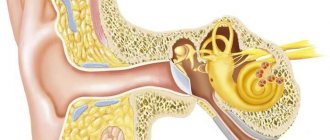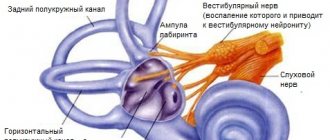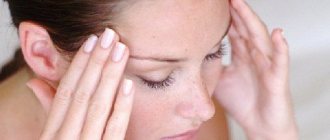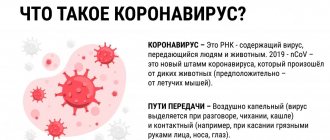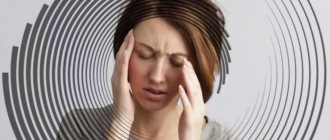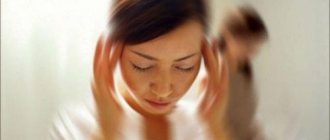General information
Vestibulopathy is a disorder of the normal functioning of the vestibular apparatus , in which characteristic symptoms appear.
The ICD-10 code for vestibulopathy is H81 (Vestibular function disorders). The normal orientation of a person in space and his balance in a vertical position is ensured by the vestibular apparatus. Disturbances in its work lead to a person experiencing confusion, dizziness , and the inability to remain in a standing position. This condition is also called labyrinthopathy. It can develop due to various reasons and diseases, developing at any age in every person. Sometimes vestibulopathy is a congenital pathology.
It may manifest itself as a separate syndrome or as a sign of neuropsychiatric disorders. In the second case, it is more difficult to treat this disease. How this pathology manifests itself, and what treatment methods are advisable to practice, will be discussed in this article.
2. Reasons
It is assumed that the source of the vestibulopathic symptom complex is inflammation of the paired vestibular nerve. Various hypotheses have been put forward as to why this particular pair of cranial nerves is involved in the inflammatory process, while the neighboring ones remain intact; In addition, the etiopathogenesis of the inflammation itself is unknown. Considering the results of numerous clinical, medical-statistical, microbiological, pathomorphological and other studies carried out in this regard, the most likely causes today seem to be neuroinfection (especially herpetic), food intoxication, immune-allergic reaction (most likely, again, this is a reaction to some kind of respiratory or other infection), or a specific, possibly genetically determined, metabolic disorder. The most well-reasoned is the viral hypothesis, which is confirmed by a large number of accumulated observations, where the chronological connection between the acute respiratory viral infection and the subsequent development of acute peripheral vestibulopathy is clearly visible; it is legitimate to assume that this connection is also cause-and-effect.
Visit our Neurology page
Pathogenesis
Vestibular insufficiency can occur at any age. Sometimes this is a congenital pathology. The pathological process is localized in the inner ear. The vestibular apparatus, which is a complex receptor of the vestibular analyzer, consists of three arches. They are located at an angle of 90 degrees to each other. They contain liquid, which is distributed through the channels depending on the position of the human body, gravity, the force of attraction, as well as the influence of a number of other factors. The brain receives impulses that determine the movements of different parts of the body. Vestibular insufficiency develops when the functioning of the vestibular apparatus is impaired.
Vestibulopathy can develop with a variety of pathogenetic variants of damage to the peripheral or central part of the vestibular analyzer, which performs three important functions - maintaining balance, spatial orientation, and image stabilization.
Classification
Depending on the nature of its origin, vestibulopathy is divided into several types:
- Vertebrogenic – develops against the background of pathologies of the cervical spine. It can be observed with osteochondrosis , osteoporosis , intervertebral hernia , etc. This form is the most common. This condition is characterized by prolonged dizziness and a feeling of head instability. When trying to focus your gaze on moving objects, discomfort occurs. Spontaneous attacks of eye rotation may occur when a person tries to turn his head sharply. They last no longer than 30 seconds.
- Peripheral - develops as a consequence of the inflammatory process in the nerve ganglia in the inner ear. Most often this occurs due to allergies or infections. With such a lesion, in addition to vestibular disorders, the patient may experience tinnitus and causeless fear. Prolonged dizziness and bouts of eye rolling are noted.
- Central - develops if disturbances occur in the function and structure of the vestibular nuclei of the medulla oblongata and cortex.
- Post-traumatic – develops after traumatic brain injury if hemorrhage occurs in the labyrinth of the inner ear. As a result, tissue damage is noted. The eardrums may also be damaged, and the ganglia of the brain may be shaken and damaged. In this case, both dizziness and other characteristic signs are noted - spontaneous eye movements, nausea, vomiting. In addition, a patient with such a lesion has an unstable gait - it is difficult for him to stand on his feet.
Cochleovestibular syndrome is also distinguished . In this condition, auditory and vestibular function is impaired. Cochleovestibular disorders are accompanied by tinnitus, hearing loss, dizziness, and imbalance.
Types of vestibulopathy syndrome
- Vertebrogenic - occurs with pathologies in the spine (with osteochondrosis, osteoporosis), with pinched nerves, instability of the cervical vertebrae.
Dizziness can be non-systemic or constant; half of the patients experience spontaneous nystagmus. Some people suffer from peripheral vertebrogenic vestibulopathy: attacks with hearing impairment begin in response to sudden head movements. With central vestibular syndrome, symptoms manifest themselves acutely - with rapid turns of the head.
- Acute peripheral vestibulopathy - the disease occurs due to inflammation of the nerve ganglion in the ear canal of a viral or infectious-allergic nature.
This form is accompanied by paroxysmal dizziness, loss of balance, involuntary eye movements in the direction of the diseased ear and preservation of hearing. It develops after ARVI. To reduce the intensity, you need to fix your gaze, and to prevent attacks, avoid sudden changes in the position of your head or body.
- Post-traumatic – occurs due to damage to the skull, traumatic brain injury, etc.
Persistent dizziness in this case is accompanied by vomiting and nausea, unsteady walking, and horizontal rotary nystagmus. Symptoms disappear after a few weeks.
Causes of vestibular apparatus disorders
The causes of dysfunction of the vestibular apparatus can be very different. Basically, vestibulopathy is provoked by the following factors:
- Cervical osteochondrosis - due to displacement of discs and vertebrae, the functioning of the vertebral artery is disrupted, which impairs blood supply. In addition, with osteochondrosis, the nerves are pinched, which also leads to dysfunction of the vestibular apparatus. Also, problems with the vestibular apparatus can be observed with intervertebral hernia, osteoporosis, etc.
- Pathologies of the inner ear - this may be a violation of lymph flow in the middle ear, inflammatory processes, otitis media, etc.
- Labyrinthitis is an inflammatory disease that provokes the development of periodic dizziness.
- Meniere's disease - during the development of the disease, pathological changes in the inner ear are noted.
- Infarction of the labyrinth – leads to impairment of hearing and function of the vestibular apparatus.
- Vestibular neuronitis is a consequence of herpetic damage to nerve fibers. If a person is diagnosed with vestibular neuronitis, it should be taken into account that signs of the disease appear periodically - during exacerbation. As a rule, this happens in spring and autumn. Also, vestibular neuritis can develop as a consequence of acute respiratory infections, influenza , etc.
- Migraine - with this disease, the symptoms are similar to vestibulopathy, but the hearing does not change.
- Diseases of the central nervous system - can cause pathological processes in the membranous labyrinth.
- Traumatic damage to the thin bone membranes of the labyrinth , in which the eardrum ruptures or hemorrhage in the middle ear - this can happen with severe coughing, straining, diving.
- Vertebrobasilar insufficiency - manifests itself mainly in older people, causing damage to the vestibular analyzers. With this pathology, the blood vessels, cerebellum and brain stems are affected. The duration of such an attack is several minutes, during which the person loses balance and orientation in space, he develops weakness, and his limbs go numb.
- Intoxication of the body due to taking certain medications.
- Neurotic disorders.
- Neuromas are tumors that form and grow from nerve cells.
- Occupational diseases – working in conditions of constant vibration or noise.
Vertebrogenic vestibulopathy
Vertebrogenic vestibulopathy is a dysfunction of the vestibular apparatus (vestibular dysfunction) with vertebrobasilar vascular insufficiency caused by degenerative-dystrophic, congenital or post-traumatic changes in the cervical spine. The high sensitivity of the vestibular analyzer, extensive reflex connections, and circulatory characteristics determine the almost constant presence of vestibular symptoms in patients with vertebrogenic vestibulopathy. According to otoneurological studies at the Scientific Center of Neurology of the Russian Academy of Medical Sciences, the components of the pathogenetic mechanisms of vertebrogenic vestibulopathy are disruption of vestibulospinal anatomical connections, changes in the blood supply to the vestibular zone of the brain stem and inner ear, as well as autonomic shifts that occur when the periarterial sympathetic plexus of the vertebral artery is irritated. A feature of vestibular dysfunction in cervical osteochondrosis is the severity and duration of autonomic reactions, which is associated with irritation of the sympathetic periarterial plexus of the vertebral artery. To diagnose vertebrogenic vestibulopathy, modern research methods are used: MRI of the cervical spine, radiography of the cervical spine with functional tests, duplex (triplex) angioscanning of the brachycephalic arteries. After further examination, patients with vertebrogenic vestibulopathy are diagnosed with instability of the cervical vertebrae and signs of extravasal compression of the vertebral arteries caused by degenerative-dystrophic changes in the cervical spine. The most common and early symptom of vestibular vertebrogenic disorders is dizziness. Some authors propose the term “cervical vertigo” for these cases. By nature, dizziness is divided into systemic, non-systemic and combined. 10% of patients experience paroxysmal dizziness (from 15 minutes to 2 hours) of the Meniere type, but without subsequent progressive cochlear disorders. In addition to dizziness, many patients experience optovestibular syndrome, which manifests itself in a feeling of instability and the appearance of “unpleasant sensations in the head” when looking at moving objects. Along with subjective vestibular symptoms, spontaneous nystagmus is detected in half of the patients. (small-spanning, horizontal, depleting). In some patients, in the absence of spontaneous nystagmus, “load nystagmus” is determined, which occurs when throwing back or turning the head, with a latent period of 15-20 seconds. In 20% of cases, peripheral vestibular syndrome is observed, manifested by attacks of systemic dizziness with pronounced autonomic reactions, provoked by sudden changes in head position and cochlear disorders in the form of noise and slight hearing loss. With central vestibular syndrome, in most patients the disease begins acutely, with vestibulo-cerebellar disorders, and is provoked by sudden turns of the head. An integrated approach to the treatment of vertebrogenic vestibulopathy in the Volyn hospital includes the prescription of vascular-metabolic drugs (Eufillin, Trental, Actovegin, Cytoflavin, Mexidol, B complex of vitamins), therapeutic exercises, gentle manual therapy, massage of the cervical-collar region, physiotherapeutic procedures , acupuncture. With adequate treatment and temporary creation of a gentle regimen (wearing a Shants collar), a gradual regression of vestibular symptoms is observed, primarily in the form of a decrease in dizziness, staggering when walking and the disappearance of spontaneous nystagmus.
Symptoms of vestibulopathy
The basis of vestibulopathy are four main symptoms:
- systemic dizziness;
- vegetative manifestations - nausea, vomiting, hyperhidrosis , heart rate disturbances, etc.;
- imbalance;
- spontaneous nystagmus .
However, disorders of the vestibular system can manifest themselves differently in different diseases. Therefore, it is important to pay attention to the following manifestations:
- I feel dizzy from time to time, and this symptom occurs quite often.
- Difficulties appear in maintaining balance - it seems that the body “does not obey” while walking or trying to move.
- Vision deteriorates, spots and goosebumps appear in the eyes.
- of migraines increases .
- Hearing deteriorates, tinnitus bothers me.
- Nystagmus is periodically observed - the movement of the eyeballs in one direction.
- Periodic nausea and vomiting.
If a person does not know what vestibular neuritis and how it manifests itself, then he can ignore the symptoms of vestibular neuritis for a long time, believing that these are just signs of overwork.
3.Symptoms
Vestibular neuronitis manifests itself acutely and occurs in paroxysms, usually in the form of a single episode, occasionally with distant relapses. In most cases, an attack of acute peripheral vestibulopathy resolves spontaneously within a few days, leaving residual symptoms that also gradually subside over a few weeks. It is known, however, that in elderly and senile people the period of convalescence (full recovery) often drags on for months.
Classic symptoms are intense, unbearable dizziness; nausea, vomiting; balance and coordination disorders. A neurological examination reveals nystagmoid movements of the eyeballs and ataxia in the Romberg position.
Diagnosis of vestibular neuronitis is quite complex; it requires a doctor to be highly qualified and have extensive clinical experience, since the same clinical manifestations are inherent in many other diseases. One of the most important differential diagnostic criteria is, in particular, the absence of hearing impairment. Differential diagnosis may also require additional studies (IMEP, MRI, etc.).
About our clinic Chistye Prudy metro station Medintercom page!
Tests and diagnostics
To establish a diagnosis, the patient must see a doctor, who first conducts a detailed survey and examination. Further, if necessary, further studies will be prescribed.
The study of the vestibular apparatus can be carried out using different methods. There are three main tests to check how the vestibular apparatus works: rotational , thermal and mechanical . In addition, you can undergo simple testing to determine the presence of coordination disorders.
With the help of such tests, a study of the functions of the vestibular apparatus for VVC in Moscow (Khimki, etc.) and other cities is carried out.
- Rotation test - to conduct it, a person sits in a chair and tilts his head forward. After this, 10 rotations are carried out over 20 seconds, then the chair suddenly stops. After this, nystagmus develops. Having measured its duration, the procedure is repeated again with rotation in the opposite direction. Normally, nystagmus will last the same amount of time - 20-50 seconds. If the difference between the two results is 25%, then we can talk about balance disorders.
- Mechanical examination - for this purpose, a rubber bulb is used, with the help of which the external auditory canal is filled with oil to displace the air from it. Next, the pear is compressed and unclenched, checking for damage to the bone capsule of the labyrinth.
- Thermal examination - the patient's ear canals are washed with water for 30 seconds.
At this time, nystagmus occurs, and assessing its duration makes it possible to determine the sensitivity of the vestibular apparatus.
Tests are carried out to determine coordination. This could be walking in a straight line with your eyes closed, trying to touch the tip of your nose with your eyes open and closed, etc.
There are other tests to determine whether the vestibular apparatus is weak or strong.
- Nystagmus can be measured using so-called Frenzel glasses . These are special magnifying glasses with bulbs equipped with light bulbs that illuminate the eyes.
- Also for this purpose, the method of electronystagmography - measuring nystagmus using electrodes.
- A neurological examination is also carried out, aimed at determining the condition of the nerve trunks of the eyeball and the muscles of the facial skull.
- MRI allows you to determine the condition of the spine.
- The inner ear and eardrum are also examined.
Other studies may be prescribed. The doctor will tell you during the consultation where to undergo such a study and what the conclusion looks like.
4.Treatment
Therapy, due to the etiological uncertainty of the disease, is palliative in nature and is aimed at eliminating the dominant symptoms. Prescribe vestibular suppressants, drugs to suppress the urge to vomit, according to indications - tranquilizers, diuretics, etc. Special vestibular gymnastics has a good effect. It is important to note that without following the instructions for the rehabilitation period, there is a very high probability of the process becoming chronic with residual clinical signs of unilateral vestibular damage.
Treatment with folk remedies
Some folk remedies can be used as auxiliary methods during the period of treatment and recovery for vestibulopathy.
- Melissa tea . 1 tbsp. l. Dried lemon balm pour 1 cup boiling water. After 10 minutes, drink with honey. It is recommended to drink this tea for dizziness twice a day.
- Infusion of parsley seeds . Finely grind parsley seeds, 1 tsp. pour the raw material into 1 glass of water and leave for 8 hours. Drink 50 ml 4 times a day.
- Infusion of nettle leaves . 1 tbsp. l. Pour dry nettle leaves into a thermos and pour 200 ml of boiling water. After two hours, strain by squeezing out the nettle leaves. Combine the resulting liquid with the same amount of fresh apple juice. Drink throughout the day. Take for two weeks.
- Essential oils . Mix 50 ml of camphor oil with 25 ml of fir oil and 10 ml of juniper. Mix thoroughly and lubricate the lymph nodes on the neck, nose and mouth with the resulting product. Please note that this product should not be applied to open wounds.
- Infusion of mistletoe and Japanese Sophora . The dry raw materials of both plants need to be crushed and mixed with 15 g of each component. Pour 500 ml of boiling water. When the product is infused, drink 100 ml before meals.
Prevention
The following prevention methods should be practiced:
- Limit situations that provoke an attack of vestibulopathy.
- Eat right, avoiding lack of vitamins and minerals. If necessary, take vitamin-mineral complexes periodically.
- Get proper rest, sleep at least 7 hours a day.
- To refuse from bad habits.
- Exercise daily, do yoga, Pilates, swimming.
- Treat bacterial and viral diseases in a timely manner.
- If vestibulopathy occurs, consult a doctor.
Diet
Salt-free diet
- Efficiency: 5-10 kg in 13 days
- Time frame: 13 days
- Cost of products: 4500-8000 rubles for 13 days
For some diseases that provoke vestibulopathy, it is recommended to adhere to a salt-free diet or limit the amount of salt in the menu.
In general, nutrition should be rational and varied, and the diet must include fresh fruits and vegetables, meat, fish, dairy products, nuts, and vegetable oils.
You should give up alcohol.
Consequences and complications
A severe complication of vestibulopathy can be purulent labyrinthitis , which, in turn, sometimes develops into meningitis . Therefore, inflammation in the inner ear must be treated under the close supervision of a doctor.
Vestibulopathy, moreover, negatively affects the overall quality of life. Dizziness and migraines impair work ability. In addition, such manifestations can cause accidents and traffic accidents.
In advanced stages, the auditory nerve may be affected, leading to the development of hearing loss.
This condition can also lead to cognitive impairment.
List of sources
- Zamergrad M.V., Grachev S.P., Gergova A.A. Acute vestibular vertigo in old age: stroke or peripheral vestibulopathy. Journal of Neurology and Psychiatry. S.S. Korsakov. Special issues. 2018; 118(6-2): 46-49.
- Parfenov V.A., Abdulina O.V., Zamergrad M.V. Differential diagnosis and treatment of vestibular vertigo // Neurology, neuropsychiatry, psychosomatics. - 2010. - No. 2. - P. 49-54.
- Suslina Z.A., Varakin Yu.Ya., Vereshchagin N.V. Vascular diseases of the brain. M. 2006.
1.General information
It is known that dizziness is one of the serious problems of modern medicine, and several scientific directions and medical specialties, as well as international and national associations, are working on this problem. Despite the prevalence and seeming self-evidence of dizziness as a pathological phenomenon, it is very difficult for researchers to give it a clear, comprehensive definition, and for patients to verbalize their sensations. In addition, today there are many known pathological conditions, diseases, syndromes, the clinical picture of which includes dizziness as the dominant or one of the leading symptoms; Accordingly, it is necessary to introduce various classifications of dizziness, based on etiological, clinical and other criteria.
Vestibular neuronitis, or acute peripheral vestibulopathy, is one of the most common causes of paroxysmal dizziness (according to various sources, the second or third most common). The disease was first described more than a hundred years ago, but many of its aspects remain unclear to this day and are the subject of study. It is generally accepted that the peak incidence occurs in young and middle age, although vestibular neuronitis is recorded with varying frequency in all age groups.
A must read! Help with treatment and hospitalization!
